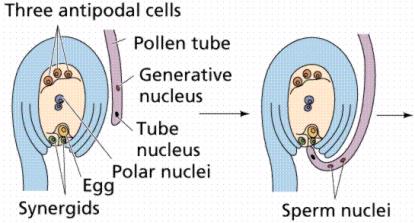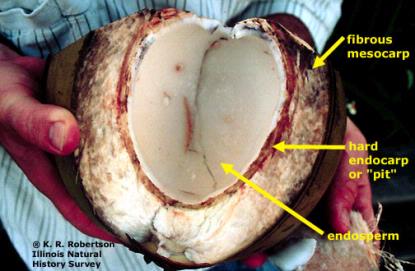I favor twitter over facebook: I don’t know the majority of the people I follow. There’s no emotional baggage and I can drop them at any time. Some are puerile, others knowledgeable in areas that I am ignorant (corporate law), some just funny. No one speaks to me directly, so I can ignore it or pay attention as I choose.
Last weekend someone tweeted: “we’re up early drinking coconut juice from young coconuts. you srsly need a power drill for that. my pal says its coconut sperm?! no way?”
Cover the children’s eyes, they shouldn’t read such filth.
It’s not sperm, it’s endosperm. There’s a big difference.
There are two basic ways a cell can divide: meiosis and mitosis. In mitosis each “daughter” cell winds up with the same amount of DNA as the parent had originally; each of your cells has 2 copies each of 23 chromosomes, for a total of 46. In meiosis, each daughter winds up with half the DNA content of the parent: 1 each of 23 chromosomes.
Sperm and eggs are the products of meiosis, so only have one copy of the chromosomes. Lovely so far.
In animals it’s simple: sperm + egg = zygote. 23 chromosomes + 23 chromosomes = 46 chromosomes. When this cell goes through mitosis all the rest of the cells will have two copies: one from mom and one from dad. Even if dad is a roustabout.
It’s much more entertaining in plants. Pollen has two sperm cells (and at least one generative cell). Notice that’s not part of the coconut damn it. The ovule has eight cells (in most species) including an egg cell and two polar nuclei (see picture). When the pollen tube erupts into the ovule (oh my) one sperm fertilizes the egg cell, the other joins with the two polar nuclei.

Now if you remember that the sperm has one copy of the chromosomes, so does each of the polar nuclei (they’re from meiosis), the new cell has three copies. It’s triploid. Whoa.
Also “whoa” is that the embryo has two copies and is diploid. Both of these separate organisms (loosely defined here) go through cell division. The triploid part becomes the endosperm which feeds the embryo when it’s ready to grow.
The whole thing is called a seed.
Back to the coconut. The coconut “water” is the nuclear phase of endosperm. It will eventually cellularize (make walls and membranes) and become the “meat” of the coconut.

Before you swear off coconuts, two thirds of the calories consumed by humans come directly from endosperm (wheat, corn, rice). Most of the meat eaten in this country gets its calories from endosperm too (unless you are eating grass pastured beef).
OK, I’ve got that out of my system.
Next time: fruit = swollen ovaries.


